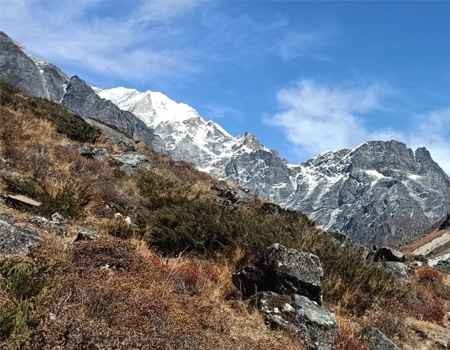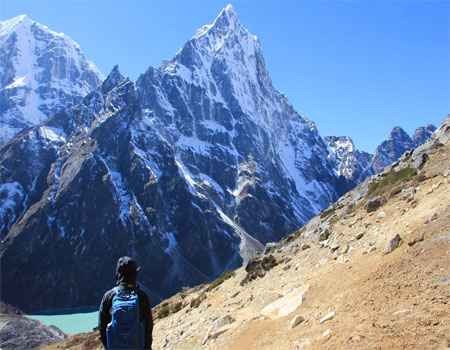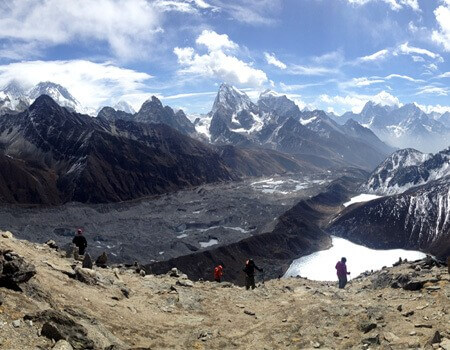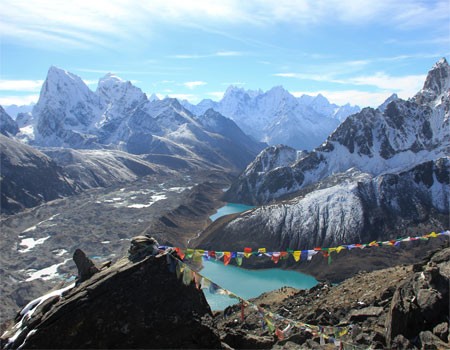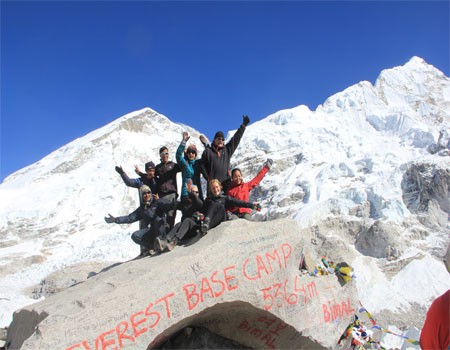A fairly glorious mountain hike to Everest Base Camp has several entries for long and short itineraries. You can choose the route plans based on your time, budget, stamina, and interest for a trekking trip to Everest Base Camp. Not only are the entry options here, but you can also see all the needed information about hiking to Everest Base Camp here on this post.
There are Driving Routes to Everest Base Camp.
The Classic Route to Everest Base Camp starts with a bus drive from Kathmandu. A few years ago, hundreds of trekkers used to go the Jiri route daily, as there was no airport to fly into Lukla from Kathmandu. To complete this classic Itinerary, trekkers should have at least three weeks.
On the classic route to Everest Base Camp, people must drive to Jiri on a bus, van, or private transport, which takes around 6-7 hours from Kathmandu. You spend a night in Jiri, Trek to Bhandar, Sette, Junbesi, Nunthala, Kharikhola, and Paiya, and meet the main Lukla to Everest Base Camp Trekking Trail.
The classic Trekking Route to Everest Base Camp joins the regular Kala Patthar Everest Base Camp Trekking route in Chaurikharka after walking around a week from Jiri. You can either trek back the same way after visiting the Base Camp to Jiri and Salleri, then drive back, or fly out from Lukla. It depends on your time and interest.
The Trekking Route from Salleri to Everest Base Camp is a new walking Route to Everest. It is even a newer trail than trekking from Lukla because I just started driving the road a few years ago. It is a shorter route than the Classic Everest Trekking Route.
You drive to Salleri from Kathmandu on a Jeep for about 7-8 hours, spend a night in Salleri or Phaplu, and start walking towards the Base Camp. You pass Nunthala, Kharikhola, and Paiya, then meet the main regular Base Camp trail in Chaurikharka. If you fly out from Lukla after exploring the Everest region, it is also about a three-week Everest Base Camp hiking journey from Kathmandu.
Things to Know About Lukla Everest Base Camp

Lukla airport
You might be interested in knowing more about the Trekking from Lukla to Everest Base Camp trip details, because it is the most popular hiking route to Everest Base Camp. It is a 12-day hike itinerary to the Base Camp, starting with a plane flight to Lukla, a trek to the Base Camp, and flying back on a plane to Kathmandu from Lukla at the end. Twelve days is a regular hiking plan, but it can be shorter by cutting one rest day or a few days longer according to your physical fitness. A 2-day acclimatization rest day is suggested for a successful Trekking trip to Everest Base Camp.
A Trekking Tour to Everest Base Camp can finish in 8 or 9 days, following the same hiking route up to Base Camp and a flight back on a Helicopter. Here, you can see a detailed 12-day Trekking itinerary in this post. Flying out from Gorakshep to Kathmandu after visiting Base Camp and Kala Patthar is a short Everest Base Camp Trek. Detailed information about the Helicopter Return Everest Base Camp Trekking package is here. So, let's check out the Regular Everest Base Camp Trekking plan here.
Lukla-Everest Base Camp Trekking Itinerary
After a half-hour flight on a small aircraft from Kathmandu, you will land at Lukla airport and begin the journey to Everest Base Camp. On this day, you will Trek to Phakding, which takes around three hours to descend the trails.
The Trekking Itinerary of the Base Bamp goes to Namche Bazar on the second day, entering the Sagarmatha National Park. This natural UNESCO heritage site begins in Monjo, where you will issue the national park entry permit. You spend an extra day in Namche doing an acclimatization hike for the altitude practice.
After that, the trek goes to Tengboche Hill, Dingboche village, Lobuche town, and Gorakshep before attempting the Base Camp hike. Visiting Kala Patthar is one of the best hill station hikes before returning to Lukla from Everest Base Camp. Check out the outline Itinerary for hiking to Everest Base Camp here.
- Fly to Lukla (2,840m) and trek to Phakding (2,610 m) in 3 hours.
- Trekking to Namche Bazaar (3,440m) 6-7 hrs
- During the day, explore the Namche Bazaar and hike for four hours to Everest View Hotel (3,880m).
- Trekking to Tengboche Hill (3,860m) 5 hrs
- Trekking to Dingboche (4,410m) 5 hrs
- Acclimatization rest day in Dingboche and hike to Nangkar-Tsang hill (5,083m): 4 hrs
- Trekking to Lobuche (4,910m) 5-6 hrs
- Trekking to Gorakshep (5,180m) 3 hours and hiking to Everest Base Camp (5,364m) 5 hours both ways
- Hiking to Kala Patthar (5,550 m) takes 2 hrs, and trekking to Pheriche (4,210 m) takes 5 hrs.
- Trekking to Namche Bazaar (3,440m) 7 hrs
- Trekking to Lukla (2,840m) 6-7 hrs
- Fly out to Kathmandu (1,350m) in 35 minutes.
The provided outline itinerary for Trekking to Everest Base Camp is to be known day by day. Find the Everest Base Camp Trekking detailed Itinerary here for more information, which might make it easier to find the condition of the trails, time, and difficulties.
Similarly, suppose you don't have enough time to properly hike from Lukla to Everest Base Camp. You can find more information about the 9-day trekking Itinerary and the shorter Base Camp Trekking details here.
Essential Things to Know About the EBC Trek
Choosing the right time to visit Everest Base Camp is the most Important Thing. You will surely enjoy the trip if you trek at the right time and season. Now that you know about choosing a suitable Trekking season for Everest Base Camp, when is the best time for the Everest Base Camp Trek?
Autumn and spring are the best times to Trek from Kathmandu. September, October, November in autumn and March, April, and May in spring are the main trekking seasons to hike to Everest Base Camp from Kathmandu. Usually, the first two weeks of September and the last two weeks of May have some rainy days.
December in winter offers one of the best views of the Himalayas and less traffic. It will be cold compared to autumn and spring, but not as cold as January and February. January and February offer clear visibility, but summer is not a good time for the Everest trip.
Know About Everest Base Camp Trekking Highlights
During the Everest Base Camp Trek, there are many natural and cultural attractions. These beautiful Highlights attract thousands of visitors to the trails every high Trekking season. Trekkers' top attraction is seeing the world's highest mountain, Everest, and reaching its base camp. The region has oodles of allure that can be seen and felt while trekking to Everest Base Camp. You can see some highlights of the Everest Base Camp trip here.
- Astonishing, adventurous, scenic flight to Lukla
- Magnificent mountain views of Langtang, Ganesh Himal, Gauri Shankar, Everest massifs, and Mt. Makalu
- Unblocked mountain and valley views from vantage viewpoints such as Kala Pathar, Everest View Hotel, Tengboche Hill, and Nangkar-Tshang Hill
- Traditional Sherpa villages with well-carved, colorful buildings
- Meet the legendary Sherpa people in the mountains; see their lifestyle, daily activities, living, culture, and religion.
- Ancient historic Buddhist monasteries, stupas, and other religious shrines
- Attractive river valleys like Dudhkoshi, Imja, and Khumbu
- A famous Khumbu glacier and icefall
- Trekking through a natural UNESCO world heritage site
- Green hills, waterfalls, vegetation, and wildlife from the National Park
The above-listed lines of the attractions are for the basic to know. For detailed information, visit this link for the highlights that will amaze you while Trekking to Everest Base Camp.
Tips for a Successful Trip to Everest Base Camp
Whatever people do, they look for a positive result. Likewise, you might be looking for tips to help you successfully travel to Everest Base Camp. First, you will manage time for Everest Adventure mountain trips with physical training and more. It may be very far from Nepal, so you will have to spend much money on the flight to Nepal. Of course, you want a successful trip and want to make it a once-in-a-lifetime experience.
Is it an easy walk to Everest Base Camp? It is not a picture of a cake! There are several difficulties, but it is not impossible. You can have a successful trek by following some helpful tips. Safety measures are the main factor, but you should also follow other things while trekking to Everest Base Camp. There are certain things to follow and respect during Trekking to the Base Camp.
Packing well, not Trekking alone during the offseason, Not disturbing wildlife, not swimming in rivers and glacial ponds, and not using a drone camera on the trek Respect culture, beware of altitude, and some other things you should follow to succeed in the Everest Base Camp Trekking trip Check out the best tips for a successful Trekking trip to Everest Base Camp.
Indian and Other South Asian Trekkers Should Know
The Itinerary, guide/porter cost, food, and lodge costs are the same for trekkers from Europe, America, and all Asian countries, as well as for people from the South Asian Association for Regional Cooperation (SAARC) nations. However, permits and domestic flight tickets are cheaper for trekkers from India. Thus, the cost of trekking to Everest Base Camp will be less for those trekkers.
Deducting the cost from the Lukla flight and national park permit doesn't make a huge difference. South Asian trekkers also need a Khumbu Pasang Lhamu Rural Municipality entry ticket, which costs the same for all trekkers worldwide.
Trekking Permit Cost for Everest Base Camp
Until the published date of this post, trekkers to Everest Base Camp need to issue two different Trekking Permits for the Everest Base Camp tour. The Everest Base Camp requires the Khumbu Pasang Lhamu Rural Municipality Entry Permit and Sagarmatha National Park Entry Permit. Trekker's Information Management System (TIMS) card was not necessary until now. However, the Trekking Agencies Association of Nepal (TAAN) will implement the TIMS card soon, collaborating with the Nepal Tourism Board (NTB).
When the TIMS card is issued for Everest Base Camp Trekking, it can be obtained from the NTB office in Bhrikutimandap, Kathmandu, for individual trekkers. If you book your trip through an agency, the Trekking company will manage this ticket. It costs 2000 NPR for a Trekker. Similarly, it costs 1,000 NPR for South Asian Trekkers.
Khumbu Pasang Lhamu Rural Municipality tickets can be issued in Lukla. The municipality has an office at the end of town where you can get an Entry Permit. The cost of this entry ticket is 2000 NPR for all trekkers.
The following required ticket is the Sagarmatha National Park Permit. On the second day of the Everest base camp journey, you can get this entry permit in Monjo on your way to Namche Bazaar. It costs 3000 NPR per person for all trekkers except those from South Asian countries, and the fee is 1500 NPR for those from South Asian nations.
Everest Base Camp Individually
Knowing how easy and difficult the Everest Base Camp Trek is for individuals is exemplary. Is trekking alone or without a guide to Everest Base Camp safe? The answer is mostly yes, but it depends on the condition of the situation and the season.
There will be lots of trekkers during the high Trekking Season. An individual trekker can follow and Trek with other group trekkers along the way to the Everest Base Camp trail. If you are thinking of hiking on your own without a guide and porter, following the other group trekkers, don't stay with the same Trekking group every moment until the Base Camp. You are better off changing the group you trek with and staying in the lodges. Be sure if they are happy to stay with you always in the mountains or not.
There won't be any problems with individual trekkers if everything runs smoothly. Trekking in the high mountain region is complex, and one might suffer from altitude sickness sometimes. Also, booking a flight ticket to Lukla and arranging accommodation in some mountainous areas can be difficult.
Things will not go wrong walking alone during high hiking season. But it is not a good idea if you are trying to trek by yourself in the offseason. There won't be many trekkers on the trail; if you have any problems, no one will know about your difficult situation.
Booking a Trek with a Local or Overseas Company
Is booking a Trekking tour to Everest Base Camp with a Local Company Compulsory? The answer is yes; you must use a Local Trekking Company to reach Everest Base Camp. Book your trip online, find any agency after arrival in Kathmandu, or book with overseas companies. Finally, using a Local Trekking Company for Everest Base Camp is Compulsory.
Why choose a Local Trekking Company for Everest Base Camp? You will get a cheaper Trekking trip if you book with a Nepal-based Local Trekking Agency. If you book your trip with a home-based Overseas Company, they need their commission and send a limited amount to the Local Agency in Nepal, where they have a deal to operate their groups. You can save that commission amount and get a better price for a trip to Everest Base Camp with a Local Company.
The other thing is information about the Everest Base Camp Trek. All the Overseas Companies are selling packages collected from different Local Agencies. You may not get a lot of information on the package page. You need to search the internet through several blog posts, which can take a long time. Not all blog posts have the correct information. If you book your Trekking Tour with a Local Company, you can ask any questions anytime and get the exact information.
A trip with a Nepal-based Local Company is very safe and easy. You can book your trip online with a secure payment.
Kathmandu-Lukla-Kathmandu flight
The primary mode of transport for the Everest Base Camp journey is a Flight to Lukla. Every morning, a small aircraft flies from Kathmandu Airport. The aircraft needs clear visibility to operate. However, Flights can often be canceled due to unfavorable weather, and trekkers are stuck in Kathmandu or Lukla. Bad weather can sometimes last a week or a few days longer.
What happens if the weather keeps getting worse for many days? If it happens, you can't fly on a plane and must start the trek by flying on a helicopter. It costs an extra amount to top up the regular Flight Ticket. Dornier and Twin-Otter planes operate the flights with little weight, so they pack only essential trekking gear to minimize weight limitation.
15kg, including hand luggage, are allowed with one ticket. You can pay 100–200 NPR per kg for overload, but the bag and you might sometimes be on a different plane due to overload. If the flight you fly on reaches Lukla and the next flight can't make a Flight, you and your Trekking Equipment can be in different places. So, try to pack only the necessary things for the trek. You can minimize weight by not carrying many books, laptops, and buying stuff for daily use while trekking to Everest Base Camp.
Accommodation, Food, and Drink While Trekking to Everest Base Camp

Gorakshep - the last place to sleep on Everest Base Camp Trek
The well-managed Trekking Route of the Everest Base Camp trail has plenty of lodges for a night's stay in every place. You can get an attached bathroom and shared bathroom accommodations during the trek. They are clean and comfortable enough, but not as clean as in the city. You can also have Luxury accommodations, but they are costly.
The lodges serve food from a menu so you can choose different foods on the trek. But one thing is for sure: you will get almost the same food items everywhere. You can also try local food if you would like to.
The lodge and grocery store sell bottles of water along the trek. The cost of the drink goes up as you ascend in altitude. Fill your water bottle with tap water, but remember to purify it before drinking.
Battery Charging, Hot Showers, and Internet Service
Camera and cell phone batteries drain quickly in cold temperatures. You can charge the Batteries during the trek, but it is not free. You will have electricity until the fourth night and solar power for the lights and battery charging. You had better bring a power bank to save money on battery charging.
As for Battery Charging, a Hot shower is also not free. Most places have a proper Hot Shower using solar, electricity, and gas. But you might need a Hot Shower with hot water in a bucket.
You can use the internet every day during the trek. There are two types of internet services: Everest Link top-up Wi-Fi cards or mobile data. NCELL and NTC provide the service in the region, but NCELL has a better signal. Upon arrival at the airport, you can buy a SIM card with a data package, which you can use during the trip.
Altitude Sickness and Prevention on the Trek
Altitude Sickness is the main problem during Trekking to Everest Base Camp. Low oxygen levels and high atmospheric pressure in the high Himalayan lands cause it. There are two types of Altitude sickness: High-Altitude Cerebral Edema (HACE) and High-Altitude Pulmonary Edema (HAPE). HACE affects the brain with fluid, and HAPE affects the lungs.
Early symptoms of the Altitude effect will make it easy to determine if someone suffers. Headache, vomiting, feeling like a drunk, tired while resting, difficulty sleeping, loss of appetite, difficulty breathing, tingling fingers, and a few others are the earlier symptoms of altitude sickness while Trekking at Everest Base Camp.
You can prevent Altitude Sickness and stay safe by strolling, drinking plenty of water and liquids, eating well, sleeping well, and staying warm. Do not think about Altitude trouble; tell the guide about the problem. Have enough acclimatization rest days before visiting higher elevations, and start taking Diamox after 3500m to prevent Altitude Sickness.
If the situation worsens after an acclimatization rest day, it is better to descend as soon as possible to the lower elevation. Having travel insurance for Everest Base Camp is highly recommended. Buy an insurance policy that covers any emergency evacuation service up to 6,000 m of elevation.
Other Beautiful Treks in the Everest Region
Gokyo Valley Trek is an alternative to Everest Base Camp Trekking. It takes a similar time frame. There are fewer trekkers than the Base Camp Trek because most would like to visit the Base Camp of the highest mountain in the world. The Gokyo Valley Trek offers even better views than the Base Camp trail. Tranquil Gokyo lakes, the most prominent mountain glacier, and the view from Gokyo Ri are phenomenal.
The Everest Three Passes Trek is the most adventurous lodge Trek in Nepal. It covers Kongma La, Cho La, and Renjo La hills. If you don't have enough time for the three-pass trek, you can trek separately, passing only Cho La or Renjo La. The Everest Base Camp and Gokyo Lakes Trek via Cho La Pass is a popular Adventure Trek in the Everest Region. Visiting a hidden valley in Thame via Renjo La Pass is also a beautiful Trek in this region.
Everest Panorama Trek: The Everest View Trek, or Lukla to Tengboche Trek, is the shortest available Everest Trekking package. It takes one week to travel from Kathmandu to Kathmandu and is recommended for non-adventurous trekkers, families, and people who do not have enough time for the Base Camp Trek.
The famous Trek itinerary to Everest Base Camp is 12 days, but you can shorten it by one day or lengthen it by a few days according to your fitness. You can minimize or maximize the walking hours and elevation by providing an itinerary. You can do it in 8 or 9 days by flying out on a helicopter after visiting the Base Camp. You can still reach the Base Camp within a few hours from Kathmandu with a helicopter tour.






